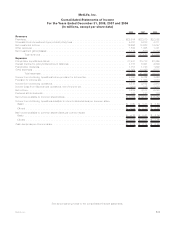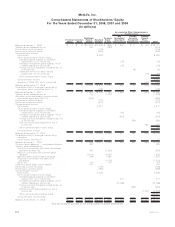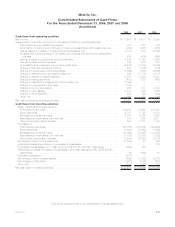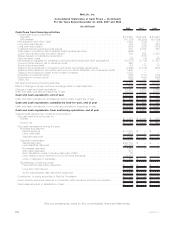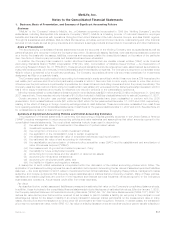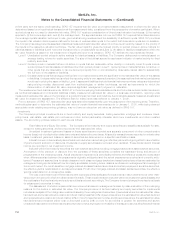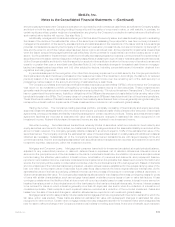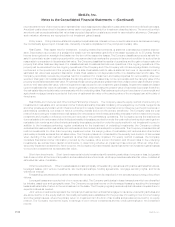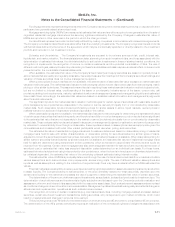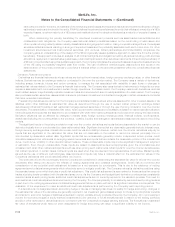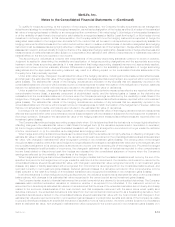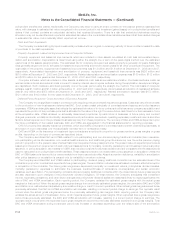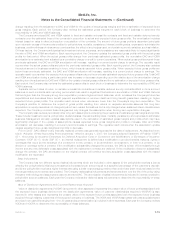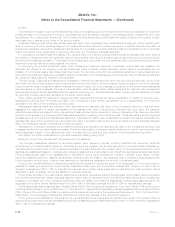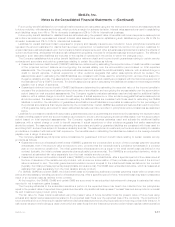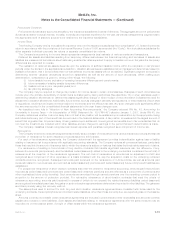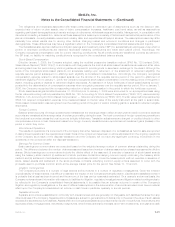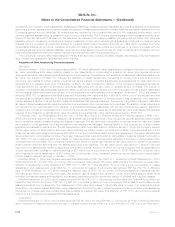MetLife 2008 Annual Report Download - page 136
Download and view the complete annual report
Please find page 136 of the 2008 MetLife annual report below. You can navigate through the pages in the report by either clicking on the pages listed below, or by using the keyword search tool below to find specific information within the annual report.To qualify for hedge accounting, at the inception of the hedging relationship, the Company formally documents its risk management
objective and strategy for undertaking the hedging transaction, as well as its designation of the hedge as either (i) a hedge of the estimated
fair value of a recognized asset or liability or an unrecognized firm commitment (“fair value hedge”); (ii) a hedge of a forecasted transaction
or of the variability of cash flows to be received or paid related to a recognized asset or liability (“cash flow hedge”); or (iii) a hedge of a net
investment in a foreign operation. In this documentation, the Company sets forth how the hedging instrument is expected to hedge the
designated risks related to the hedged item and sets forth the method that will be used to retrospectively and prospectively assess the
hedging instrument’s effectiveness and the method which will be used to measure ineffectiveness. A derivative designated as a hedging
instrument must be assessed as being highly effective in offsetting the designated risk of the hedged item. Hedge effectiveness is formally
assessed at inception and periodically throughout the life of the designated hedging relationship. Assessments of hedge effectiveness and
measurements of ineffectiveness are also subject to interpretation and estimation and different interpretations or estimates may have a
material effect on the amount reported in net income.
The accounting for derivatives is complex and interpretations of theprimaryaccountingstandardscontinuetoevolveinpractice.
Judgment is applied in determining the availability and application of hedge accounting designations and the appropriate accounting
treatment under these accounting standards. If it was determined that hedge accounting designations were not appropriately applied,
reported net income could be materially affected. Differences in judgment as to the availability and application of hedge accounting
designations and the appropriate accounting treatment may result in a differing impact on the consolidated financial statements of the
Company from that previously reported.
Under a fair value hedge, changes in the estimated fair value of the hedging derivative, including amounts measured as ineffectiveness,
and changes in the estimated fair value of the hedged item related to the designated risk being hedged, are reported within net investment
gains (losses). The estimated fair values of the hedging derivatives are exclusive of any accruals that are separately reported in the
consolidated statement of income within interest income or interest expense to match the location of the hedged item. However, balances
that are not scheduled to settle until maturity are included in the estimated fair value of derivatives.
Under a cash flow hedge, changes in the estimated fair value of the hedging derivative measured as effective are reported within other
comprehensive income (loss), a separate component of stockholders’ equity, and the deferred gains or losses on the derivative are
reclassified into the consolidated statement of income when the Company’s earnings are affected by the variability in cash flows of the
hedged item. Changes in the estimated fair value of the hedging instrument measured as ineffectiveness are reported within net investment
gains (losses). The estimated fair values of the hedging derivatives are exclusive of any accruals that are separately reported in the
consolidated statement of income within interest income or interest expense to match the location of the hedged item. However, balances
that are not scheduled to settle until maturity are included in the estimated fair value of derivatives.
In a hedge of a net investment in a foreign operation, changes in the estimated fair value of the hedging derivative that are measured as
effective are reported within other comprehensive income (loss) consistent with the translation adjustment for the hedged net investment in
the foreign operation. Changes in the estimated fair value of the hedging instrument measured as ineffectiveness are reported within net
investment gains (losses).
The Company discontinues hedge accounting prospectively when: (i) it is determined that the derivative is no longer highly effective in
offsetting changes in the estimated fair value or cash flows of a hedged item; (ii) the derivative expires, is sold, terminated, or exercised;
(iii) it is no longer probable that the hedged forecasted transaction will occur; (iv) a hedged firm commitment no longer meets the definition
of a firm commitment; or (v) the derivative is de-designated as a hedging instrument.
When hedge accounting is discontinued because it is determined that the derivative is not highly effective in offsetting changes in the
estimate fair value or cash flows of a hedged item, the derivative continues to be carried on the consolidated balance sheet at its estimated
fair value, with changes in estimated fair value recognized currently in net investment gains (losses). The carrying value of the hedged
recognized asset or liability under a fair value hedge is no longer adjusted for changes in its estimated fair value due to the hedged risk, and
the cumulative adjustment to its carrying value is amortized into income over the remaining life of the hedged item. Provided the hedged
forecasted transaction is still probable of occurrence, the changes in estimated fair value of derivatives recorded in other comprehensive
income (loss) related to discontinued cash flow hedges are released into the consolidated statement of income when the Company’s
earnings are affected by the variability in cash flows of the hedged item.
When hedge accounting is discontinued because it is no longer probable that the forecasted transactions will occur by the end of the
specified time period or the hedged item no longer meets the definition of a firm commitment, the derivative continues to be carried on the
consolidated balance sheet at its estimated fair value, with changes in estimated fair value recognized currently in net investment gains
(losses). Any asset or liability associated with a recognized firm commitment is derecognized from the consolidated balance sheet, and
recorded currently in net investment gains (losses). Deferred gains and losses of a derivative recorded in other comprehensive income
(loss) pursuant to the cash flow hedge of a forecasted transaction are recognized immediately in net investment gains (losses).
In all other situations in which hedge accounting is discontinued, the derivative is carried at its estimated fair value on the consolidated
balance sheet, with changes in its estimated fair value recognized in the current period as net investment gains (losses).
The Company is also a party to financial instruments that contain terms which are deemed to be embedded derivatives. The Company
assesses each identified embedded derivative to determine whether it is required to be bifurcated. If the instrument would not be
accounted for in its entirety at estimated fair value and it is determined that the terms of the embedded derivative are not clearly and closely
related to the economic characteristics of the host contract, and that a separate instrument with the same terms would qualify as a
derivative instrument, the embedded derivative is bifurcated from the host contract and accounted for as a freestanding derivative. Such
embedded derivatives are carried on the consolidated balance sheet at estimated fair value with the host contract and changes in their
estimated fair value are reported currently in net investment gains (losses) or in policyholder benefits and claims. If the Company is unable
to properly identify and measure an embedded derivative for separation from its host contract, the entire contract is carried on the balance
sheet at estimated fair value, with changes in estimated fair value recognized in the current period in net investment gains (losses) or in
F-13MetLife, Inc.
MetLife, Inc.
Notes to the Consolidated Financial Statements — (Continued)


